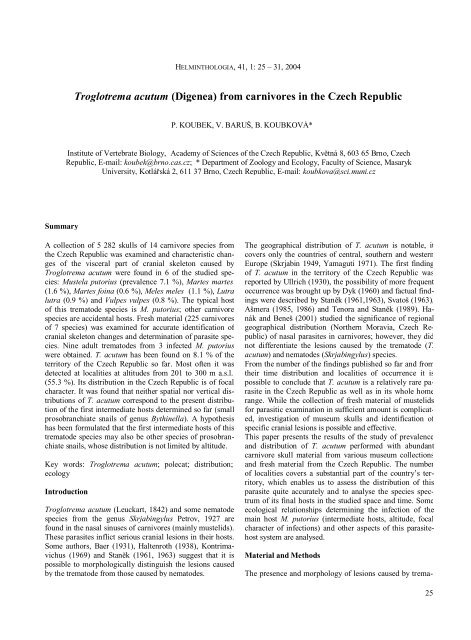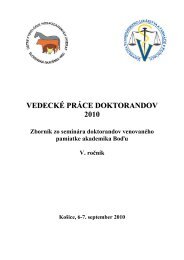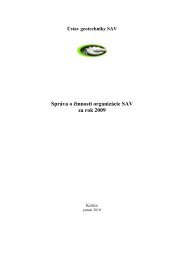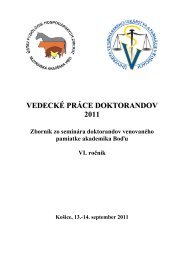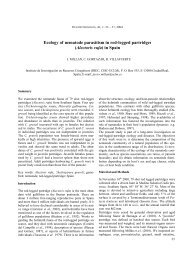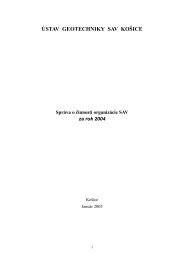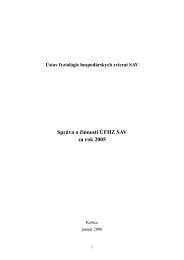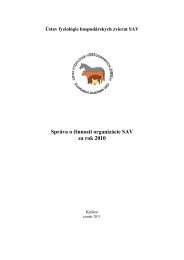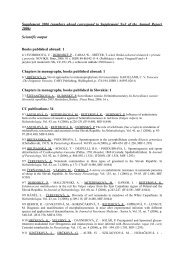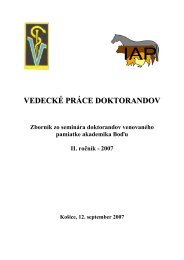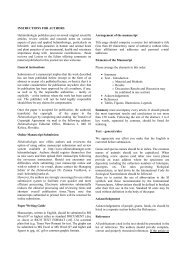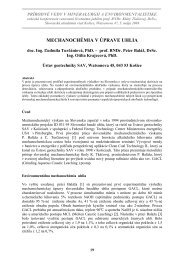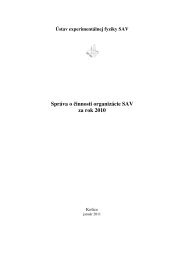Troglotrema acutum (Digenea) from carnivores in the Czech Republic
Troglotrema acutum (Digenea) from carnivores in the Czech Republic
Troglotrema acutum (Digenea) from carnivores in the Czech Republic
You also want an ePaper? Increase the reach of your titles
YUMPU automatically turns print PDFs into web optimized ePapers that Google loves.
Summary<br />
HELMINTHOLOGIA, 41, 1: 25 – 31, 2004<br />
<strong>Troglotrema</strong> <strong>acutum</strong> (<strong>Digenea</strong>) <strong>from</strong> <strong>carnivores</strong> <strong>in</strong> <strong>the</strong> <strong>Czech</strong> <strong>Republic</strong><br />
P. KOUBEK, V. BARU�, B. KOUBKOVÁ*<br />
Institute of Vertebrate Biology, Academy of Sciences of <strong>the</strong> <strong>Czech</strong> <strong>Republic</strong>, Kv�tná 8, 603 65 Brno, <strong>Czech</strong><br />
<strong>Republic</strong>, E-mail: koubek@brno.cas.cz; * Department of Zoology and Ecology, Faculty of Science, Masaryk<br />
University, Kotlá�ská 2, 611 37 Brno, <strong>Czech</strong> <strong>Republic</strong>, E-mail: koubkova@sci.muni.cz<br />
A collection of 5 282 skulls of 14 carnivore species <strong>from</strong><br />
<strong>the</strong> <strong>Czech</strong> <strong>Republic</strong> was exam<strong>in</strong>ed and characteristic changes<br />
of <strong>the</strong> visceral part of cranial skeleton caused by<br />
<strong>Troglotrema</strong> <strong>acutum</strong> were found <strong>in</strong> 6 of <strong>the</strong> studied species:<br />
Mustela putorius (prevalence 7.1 %), Martes martes<br />
(1.6 %), Martes fo<strong>in</strong>a (0.6 %), Meles meles (1.1 %), Lutra<br />
lutra (0.9 %) and Vulpes vulpes (0.8 %). The typical host<br />
of this trematode species is M. putorius; o<strong>the</strong>r carnivore<br />
species are accidental hosts. Fresh material (225 <strong>carnivores</strong><br />
of 7 species) was exam<strong>in</strong>ed for accurate identification of<br />
cranial skeleton changes and determ<strong>in</strong>ation of parasite species.<br />
N<strong>in</strong>e adult trematodes <strong>from</strong> 3 <strong>in</strong>fected M. putorius<br />
were obta<strong>in</strong>ed. T. <strong>acutum</strong> has been found on 8.1 % of <strong>the</strong><br />
territory of <strong>the</strong> <strong>Czech</strong> <strong>Republic</strong> so far. Most often it was<br />
detected at localities at altitudes <strong>from</strong> 201 to 300 m a.s.l.<br />
(55.3 %). Its distribution <strong>in</strong> <strong>the</strong> <strong>Czech</strong> <strong>Republic</strong> is of focal<br />
character. It was found that nei<strong>the</strong>r spatial nor vertical distributions<br />
of T. <strong>acutum</strong> correspond to <strong>the</strong> present distribution<br />
of <strong>the</strong> first <strong>in</strong>termediate hosts determ<strong>in</strong>ed so far (small<br />
prosobranchiate snails of genus Byth<strong>in</strong>ella). A hypo<strong>the</strong>sis<br />
has been formulated that <strong>the</strong> first <strong>in</strong>termediate hosts of this<br />
trematode species may also be o<strong>the</strong>r species of prosobranchiate<br />
snails, whose distribution is not limited by altitude.<br />
Key words: <strong>Troglotrema</strong> <strong>acutum</strong>; polecat; distribution;<br />
ecology<br />
Introduction<br />
<strong>Troglotrema</strong> <strong>acutum</strong> (Leuckart, 1842) and some nematode<br />
species <strong>from</strong> <strong>the</strong> genus Skrjab<strong>in</strong>gylus Petrov, 1927 are<br />
found <strong>in</strong> <strong>the</strong> nasal s<strong>in</strong>uses of <strong>carnivores</strong> (ma<strong>in</strong>ly mustelids).<br />
These parasites <strong>in</strong>flict serious cranial lesions <strong>in</strong> <strong>the</strong>ir hosts.<br />
Some authors, Baer (1931), Haltenroth (1938), Kontrimavichus<br />
(1969) and Stan�k (1961, 1963) suggest that it is<br />
possible to morphologically dist<strong>in</strong>guish <strong>the</strong> lesions caused<br />
by <strong>the</strong> trematode <strong>from</strong> those caused by nematodes.<br />
The geographical distribution of T. <strong>acutum</strong> is notable, it<br />
covers only <strong>the</strong> countries of central, sou<strong>the</strong>rn and western<br />
Europe (Skrjab<strong>in</strong> 1949, Yamaguti 1971). The first f<strong>in</strong>d<strong>in</strong>g<br />
of T. <strong>acutum</strong> <strong>in</strong> <strong>the</strong> territory of <strong>the</strong> <strong>Czech</strong> <strong>Republic</strong> was<br />
reported by Ullrich (1930), <strong>the</strong> possibility of more frequent<br />
occurrence was brought up by Dyk (1960) and factual f<strong>in</strong>d<strong>in</strong>gs<br />
were described by Stan�k (1961,1963), Svato� (1963),<br />
��mera (1985, 1986) and Tenora and Stan�k (1989). Hanák<br />
and Bene� (2001) studied <strong>the</strong> significance of regional<br />
geographical distribution (Nor<strong>the</strong>rn Moravia, <strong>Czech</strong> <strong>Republic</strong>)<br />
of nasal parasites <strong>in</strong> <strong>carnivores</strong>; however, <strong>the</strong>y did<br />
not differentiate <strong>the</strong> lesions caused by <strong>the</strong> trematode (T.<br />
<strong>acutum</strong>) and nematodes (Skrjab<strong>in</strong>gylus) species.<br />
From <strong>the</strong> number of <strong>the</strong> f<strong>in</strong>d<strong>in</strong>gs published so far and <strong>from</strong><br />
<strong>the</strong>ir time distribution and localities of occurrence it is<br />
possible to conclude that T. <strong>acutum</strong> is a relatively rare parasite<br />
<strong>in</strong> <strong>the</strong> <strong>Czech</strong> <strong>Republic</strong> as well as <strong>in</strong> its whole home<br />
range. While <strong>the</strong> collection of fresh material of mustelids<br />
for parasitic exam<strong>in</strong>ation <strong>in</strong> sufficient amount is complicated,<br />
<strong>in</strong>vestigation of museum skulls and identification of<br />
specific cranial lesions is possible and effective.<br />
This paper presents <strong>the</strong> results of <strong>the</strong> study of prevalence<br />
and distribution of T. <strong>acutum</strong> performed with abundant<br />
carnivore skull material <strong>from</strong> various museum collections<br />
and fresh material <strong>from</strong> <strong>the</strong> <strong>Czech</strong> <strong>Republic</strong>. The number<br />
of localities covers a substantial part of <strong>the</strong> country’s territory,<br />
which enables us to assess <strong>the</strong> distribution of this<br />
parasite quite accurately and to analyse <strong>the</strong> species spectrum<br />
of its f<strong>in</strong>al hosts <strong>in</strong> <strong>the</strong> studied space and time. Some<br />
ecological relationships determ<strong>in</strong><strong>in</strong>g <strong>the</strong> <strong>in</strong>fection of <strong>the</strong><br />
ma<strong>in</strong> host M. putorius (<strong>in</strong>termediate hosts, altitude, focal<br />
character of <strong>in</strong>fections) and o<strong>the</strong>r aspects of this parasitehost<br />
system are analysed.<br />
Material and Methods<br />
The presence and morphology of lesions caused by tremadfksôajkdsjôfja<br />
25
Species<br />
Table 1. Survey of <strong>the</strong> exam<strong>in</strong>ed species of <strong>carnivores</strong> <strong>in</strong> <strong>the</strong> <strong>Czech</strong> <strong>Republic</strong><br />
NM Prague MM Brno SM Opava IVB CzAS Total<br />
n Positive n Positive n Positive n Positive n Positive<br />
Mustelidae<br />
M.nivalis 141 0 68 0 699 0 346 0 1254 0<br />
M. erm<strong>in</strong>ea 59 0 64 0 99 0 102 0 324 0<br />
M. putorius 189 2 232 20 189 38 547 22 1157 82<br />
M. eversmannii 21 0 29 0 5 0 14 0 69 0<br />
M. martes 67 1 128 1 72 2 175 3 442 7<br />
M. fo<strong>in</strong>a 139 1 153 2 177 0 243 1 712 4<br />
M. vison 14 0 18 0 24 0 56 0<br />
L. lutra 86 0 11 0 4 0 10 1 111 1<br />
M. meles 100 0 37 0 16 0 31 2 184 2<br />
Felidae<br />
L. lynx 75* 0 75 0<br />
F. silvestris 1 0 1 0<br />
Canidae<br />
V. vulpes 189 2 246 2 96 1<br />
N.procyonoides 2 0 7 0<br />
Procyonidae<br />
P. lotor 2 0 2 0<br />
Total 1007 6 986 25 1364 41 1927 35 5282 101<br />
NM Prague – National Museum Prague; MM Brno – Moravian Museum Brno; SM Opava – Silesian Museum, Opava; IVB, CzAS – Institute of<br />
Vertebrate Biology CzAS, Brno; * – �ervený and Koubek (2000)<br />
todes <strong>in</strong> 5 282 skulls of <strong>carnivores</strong> (11 autochthonous species<br />
and 3 allochthonous species) <strong>from</strong> <strong>Czech</strong> <strong>Republic</strong><br />
were evaluated. The studied skulls were collected over a<br />
relatively long period (1949-2002) and were obta<strong>in</strong>ed <strong>from</strong><br />
four skull collections <strong>in</strong> <strong>the</strong> <strong>Czech</strong> scientific <strong>in</strong>stitutions:<br />
National Museum, Prague, Moravian Museum, Brno, Silesian<br />
Museum, Opava and Institute of Vertebrate Biology<br />
CzAS, Brno. This skull material was prepared <strong>in</strong> a standard<br />
way as dried museum material. Apart <strong>from</strong> <strong>the</strong> dry material,<br />
we also exam<strong>in</strong>ed 39 fresh skulls of Mustela putorius,<br />
12 skulls of M. eversmannii, 3 skulls of M. erm<strong>in</strong>ea,<br />
5 skulls of M. nivalis, 24 skulls of M. vison, 62 skulls<br />
of Martes fo<strong>in</strong>a, 5 skulls of M. martes, 74 skulls of Vulpes<br />
vulpes and 1 skull of Nyctereutes procyonoides. From 3<br />
<strong>in</strong>fected specimens of M. putorius we obta<strong>in</strong>ed 9 adult T.<br />
<strong>acutum</strong> (Fig. 1). The numbers of <strong>carnivores</strong> exam<strong>in</strong>ed <strong>from</strong><br />
<strong>in</strong>dividual collections are presented <strong>in</strong> Table 1.<br />
Skulls were regarded as damaged by <strong>the</strong> T. <strong>acutum</strong> <strong>in</strong>fection<br />
when <strong>the</strong>y did not show lesions caused by preparation,<br />
shots or strokes and when <strong>the</strong>y exhibited some of <strong>the</strong> follow<strong>in</strong>g<br />
changes <strong>in</strong> <strong>the</strong> parasitised cranial skeleton: 1. Evident<br />
asymmetry; 2. Perforations, even <strong>in</strong> <strong>the</strong> absence of<br />
asymmetry; 3. Presence of considerably large th<strong>in</strong>ned areas<br />
of <strong>the</strong> bone wall when <strong>the</strong> cranium was o<strong>the</strong>rwise robust. A<br />
typical attribute of cranial lesions caused by T. <strong>acutum</strong><br />
<strong>in</strong>fection is <strong>the</strong> changed bone structure over a large area,<br />
which may cover <strong>the</strong> whole nasal part of <strong>the</strong> skull. The<br />
bone perforations are large and notably asymmetric with<br />
26<br />
347<br />
10<br />
0<br />
0<br />
878<br />
19<br />
Fig. 1. <strong>Troglotrema</strong> <strong>acutum</strong> (Leuckart, 1842) <strong>from</strong> Mustela<br />
putorius (L.). Total view (Orig<strong>in</strong>al)<br />
7<br />
0
uneven edges (Fig. 2). In each of <strong>the</strong> f<strong>in</strong>d<strong>in</strong>gs we recorded<br />
<strong>the</strong> type of <strong>the</strong> defect and number of perforations. To<br />
express <strong>the</strong> geographical distribution of T. <strong>acutum</strong> we used<br />
solely <strong>the</strong> material with exactly determ<strong>in</strong>ed locality of orig<strong>in</strong><br />
and date of collection. Standard grid maps were used<br />
for <strong>the</strong> mapp<strong>in</strong>g <strong>the</strong> distribution of T. <strong>acutum</strong>. This system<br />
is based on geographic coord<strong>in</strong>ates (P6’ x 10’) and <strong>the</strong> territory<br />
of <strong>the</strong> <strong>Czech</strong> <strong>Republic</strong> is divided <strong>in</strong>to quadrate<br />
format tetragons of approximately 11.2 x 12 km. A similar<br />
approach has been applied <strong>in</strong> <strong>the</strong> mapp<strong>in</strong>g of mammals and<br />
birds (And�ra and Hanzal, 1996).<br />
Results<br />
Fig. 2. Polecat skull (Mustela putorius) with changes typical for<br />
<strong>Troglotrema</strong> <strong>acutum</strong> trematode <strong>in</strong>fection (Photo by R. Bla�ek)<br />
<strong>in</strong>tensity was <strong>in</strong> most cases relatively low. In M. martes<br />
only 1 – 3 perforations were found, <strong>in</strong> M. fo<strong>in</strong>a 1 – 4 and <strong>in</strong><br />
V. vulpes we found 1 – 2 perforations.<br />
Total and often multiple perforations of bones <strong>in</strong> <strong>the</strong> nasal<br />
part of <strong>the</strong> skull were detected <strong>in</strong> most of <strong>the</strong> hosts. All of<br />
<strong>the</strong> positive cases comb<strong>in</strong>ed 2 or 3 types of skeleton damage.<br />
Only <strong>in</strong> <strong>the</strong> case of L. lutra and M. meles did <strong>the</strong> <strong>in</strong>fection<br />
manifest itself by <strong>the</strong> formation of net-shaped deformation<br />
of frontal and part of <strong>the</strong> parietal bones. The data<br />
on frequency of <strong>the</strong> <strong>in</strong>dividual types of skull damage are<br />
presented <strong>in</strong> Table 2.<br />
Fig. 3. Quantification of damage to <strong>the</strong> visceral part of <strong>the</strong> cranial<br />
skeleton <strong>in</strong> M. putorius accord<strong>in</strong>g to number of perforations<br />
1. Species spectrum of hosts and prevalence values of T.<br />
<strong>acutum</strong><br />
Out of <strong>the</strong> total number of 14 carnivore species of 4 families<br />
liv<strong>in</strong>g <strong>in</strong> <strong>the</strong> <strong>Czech</strong> <strong>Republic</strong> (Table 1), <strong>the</strong> <strong>in</strong>fection<br />
Species<br />
with T. <strong>acutum</strong> was found only <strong>in</strong> hosts <strong>from</strong> Mustelidae (5 Mustela putorius 82 1 1 82<br />
species) and Canidae (1 species). The highest prevalence Martes martes 7 1 7<br />
value (<strong>in</strong> %) was found <strong>in</strong> M. putorius (7.1). Lower values Martes fo<strong>in</strong>a 4 4<br />
were found for Martes martes (1.6), Meles meles (1.1), Lutra lutra 1 1 1<br />
Lutra lutra (0.9), Martes fo<strong>in</strong>a (0.6) and Vulpes vulpes Meles meles 2 2<br />
(0.8). The results suggest that M. putorius is <strong>the</strong> ma<strong>in</strong> host<br />
of T. <strong>acutum</strong>.<br />
Vulpes vulpes 7 1 7<br />
2. Frequency of occurrence of perforations and <strong>in</strong>dividual<br />
types of damage to <strong>the</strong> visceral part of cranial skeleton<br />
A detailed analysis of this parameter could be performed<br />
only for M. putorius due to <strong>the</strong> sufficient number of positive<br />
<strong>in</strong>dividuals (Fig. 3). In this host <strong>the</strong> number of perforations<br />
found <strong>in</strong> <strong>the</strong> visceral part of cranial skeleton was<br />
with<strong>in</strong> a wide range, <strong>from</strong> 1 to 13. Out of <strong>the</strong> affected<br />
skulls, 34.2 % had only one perforation, 17.1 % two, 14.6<br />
% three, 9.8 % four and 7.3 % five perforations. Higher<br />
numbers of perforations <strong>from</strong> 6 to 13 have very low frequency<br />
(3.7 – 1.2 %). In <strong>the</strong> rest of <strong>the</strong> hosts <strong>the</strong> <strong>in</strong>fection<br />
Table 2. Frequency (%) of <strong>the</strong> occurrence of different types of cranial<br />
skeleton lesions <strong>in</strong> <strong>carnivores</strong> caused by T. <strong>acutum</strong> <strong>in</strong>fection<br />
Positive Net<br />
th<strong>in</strong>ned<br />
Asymmetry Perforation<br />
3. Geographical distribution of T. <strong>acutum</strong> <strong>in</strong> <strong>the</strong> <strong>Czech</strong><br />
<strong>Republic</strong><br />
The occurrence of T. <strong>acutum</strong> has been confirmed on 35<br />
map squares, that is 5.6 % of <strong>the</strong> total number of 628 squares<br />
cover<strong>in</strong>g <strong>the</strong> territory of <strong>the</strong> CzR (Fig. 4). The dom<strong>in</strong>ant<br />
position of M. putorius <strong>in</strong> <strong>the</strong> natural range of T. <strong>acutum</strong><br />
is proved by <strong>the</strong> fact that <strong>the</strong> localities with positive<br />
f<strong>in</strong>d<strong>in</strong>gs <strong>in</strong> M. putorius alone or with o<strong>the</strong>r <strong>carnivores</strong> cover<br />
33 map squares (i.e. 94.3 % of <strong>the</strong> <strong>in</strong>fected area of <strong>the</strong><br />
CzR). Positive f<strong>in</strong>d<strong>in</strong>gs <strong>in</strong> hosts (M. martes, M. fo<strong>in</strong>a, M.<br />
meles, Lutra lutra) o<strong>the</strong>r than M. putorius were detected <strong>in</strong><br />
27
6 squares (15.4 %) only. If we complement <strong>the</strong> positive<br />
f<strong>in</strong>d<strong>in</strong>gs of T. <strong>acutum</strong> <strong>from</strong> our material with previously<br />
published data, <strong>the</strong>n this trematode has been reported <strong>from</strong><br />
51 squares so far, which represents 8.1 % of <strong>the</strong> area of <strong>the</strong><br />
CzR. Comparison of <strong>the</strong> localities with T. <strong>acutum</strong> with <strong>the</strong><br />
mapp<strong>in</strong>g grid <strong>in</strong>dicates <strong>the</strong> presence of preferred smaller or<br />
larger regions bound to river or pond ecosystems <strong>in</strong> sou<strong>the</strong>rn<br />
Bohemia, �eskomoravská vrchov<strong>in</strong>a Highlands<br />
and especially <strong>in</strong> nor<strong>the</strong>rn and sou<strong>the</strong>rn Moravia.<br />
Fig. 4. Geographical distribution of T. <strong>acutum</strong> <strong>in</strong> <strong>the</strong> <strong>Czech</strong><br />
<strong>Republic</strong> (l – our f<strong>in</strong>d<strong>in</strong>gs;¡ – o<strong>the</strong>r published data)<br />
4. Vertical distribution of T. <strong>acutum</strong> <strong>in</strong> <strong>the</strong> <strong>Czech</strong> <strong>Republic</strong><br />
Vertical distribution of T. <strong>acutum</strong> was recorded for all<br />
f<strong>in</strong>d<strong>in</strong>gs of <strong>in</strong>fected hosts. Positive f<strong>in</strong>d<strong>in</strong>gs appeared <strong>in</strong><br />
hosts <strong>from</strong> localities with altitudes <strong>from</strong> 167 to 745 m a.s.l.<br />
The majority of <strong>the</strong> f<strong>in</strong>d<strong>in</strong>gs (91.1 %) lay under 450 m<br />
a.s.l., and 55.3 % of <strong>the</strong> f<strong>in</strong>d<strong>in</strong>gs were <strong>from</strong> <strong>the</strong> range 201-<br />
300 m a.s.l. (Fig. 5).<br />
Fig. 5. Vertical distribution of T. <strong>acutum</strong> f<strong>in</strong>d<strong>in</strong>gs <strong>in</strong> <strong>the</strong> <strong>Czech</strong><br />
<strong>Republic</strong><br />
5. Focal character of T. <strong>acutum</strong> <strong>in</strong>fections<br />
Geographical aspects of T. <strong>acutum</strong> distribution <strong>in</strong>dicate <strong>the</strong><br />
existence of foci of this parasite. We consider <strong>the</strong> repeated<br />
dfôkjsgôdfjgôsdjfgô<br />
28<br />
f<strong>in</strong>d<strong>in</strong>gs of this parasite at <strong>the</strong> same locality (same map<br />
square) and with<strong>in</strong> <strong>the</strong> period of two and more years to be<br />
<strong>the</strong> evidence of <strong>the</strong> existence of <strong>the</strong>se focuses. Repeated<br />
f<strong>in</strong>d<strong>in</strong>gs of T. <strong>acutum</strong> <strong>in</strong> M. putorius appeared <strong>in</strong> 14 squares<br />
<strong>in</strong> <strong>the</strong> period <strong>from</strong> 1957 to 2001 (Table 3). M. putorius<br />
was <strong>the</strong> s<strong>in</strong>gle host at 64.3 % of <strong>the</strong> <strong>in</strong>fected area (9 squares).<br />
Common <strong>in</strong>fection with M. martes was found at 21.4<br />
% of <strong>the</strong> area (3 squares) and with V. vulpes at 14.3 % of<br />
<strong>the</strong> area (2 squares). The significance of M. putorius as <strong>the</strong><br />
ma<strong>in</strong> host for persistence of <strong>the</strong> focuses of T. <strong>acutum</strong> <strong>in</strong>fection<br />
is also confirmed by <strong>the</strong> fact that <strong>in</strong> o<strong>the</strong>r <strong>carnivores</strong><br />
<strong>the</strong> <strong>in</strong>fection with this trematode was found at 7<br />
squares only, but always <strong>in</strong> a s<strong>in</strong>gle host species and <strong>in</strong> a<br />
s<strong>in</strong>gle year (<strong>in</strong> V. vulpes - 3 localities, M. martes, L. lutra<br />
and M. meles - 1 locality). Only <strong>in</strong> one case at one locality<br />
was <strong>the</strong> <strong>in</strong>fection detected <strong>in</strong> two host species (M. martes,<br />
M. fo<strong>in</strong>a).<br />
Table 3. Localities of repeated occurrence of T. <strong>acutum</strong> <strong>in</strong> <strong>the</strong> <strong>Czech</strong><br />
<strong>Republic</strong><br />
Quadrat Locality Repeated Time Host (s)*<br />
Nos. f<strong>in</strong>d<strong>in</strong>gs range<br />
6167 Záb�eh n. Morav� 7 57 – 59 M.p., M.ma.<br />
6962 Rouchovany 3 89 – 01 M.p.<br />
6965 �idlochovice 5 62 – 87 M.p., M.ma.<br />
7065 Poho�elice 2 69 – 84 M.p., V.v.<br />
6865 Bosonohy 4 62 – 73 M.p. M.me.<br />
6072 Hlavnice 10 67 – 71 M.p., M.ma.<br />
6073 Opava 3 64 – 66 M.p., V.v.<br />
6275 Polanka 2 61 – 71 M.p.<br />
6172 �táblovice 5 62 – 74 M.p.<br />
6174 Háj 4 67 – 70 M.p.<br />
6074 Krava�e 13 58 – 91 M.p.<br />
*) M.p. – Mustela putorius; M.ma. – Martes martes; M. me. – Meles<br />
meles; V.v. – Vulpes vulpes<br />
Discussion<br />
T. <strong>acutum</strong> was orig<strong>in</strong>ally described by Leuckart (1842) as<br />
Distoma <strong>acutum</strong>. Host of <strong>the</strong> type material was M. putorius<br />
<strong>from</strong> Germany. This trematode was later classed <strong>in</strong>to a<br />
newly created genus, <strong>Troglotrema</strong>, by Odhner (1914), who<br />
revised <strong>the</strong> collection of trematodes obta<strong>in</strong>ed by Moniez<br />
(1890) <strong>from</strong> polecats <strong>in</strong> France. Odhner’s description toge<strong>the</strong>r<br />
with <strong>the</strong> description and illustration of an adult trematode<br />
by Baer (1931) present <strong>the</strong> most detailed data<br />
about morphometry of this species so far. The trematodes<br />
obta<strong>in</strong>ed <strong>from</strong> our material fully correspond to <strong>the</strong> descriptions<br />
of T. <strong>acutum</strong> published up to <strong>the</strong> present.<br />
Unfortunately, most of <strong>the</strong> papers about <strong>the</strong> occurrence and<br />
distribution of T. <strong>acutum</strong> <strong>in</strong> <strong>the</strong> <strong>Czech</strong> <strong>Republic</strong> as well as<br />
<strong>in</strong> o<strong>the</strong>r regions published so far are based on <strong>the</strong> presence<br />
of changes <strong>in</strong> <strong>the</strong> visceral part of <strong>the</strong> skull (Stan�k, 1961;<br />
Schmidt, 1993; Hanák and Bene�, 2001). Although some<br />
authors express <strong>the</strong>ir doubts (Olt, 1929; Kotlán, 1960),<br />
such changes may also be caused by nematodes of <strong>the</strong> gedfôkjsgôdfjgôsdjfgô
nus Skrjab<strong>in</strong>gylus (Hansson, 1968; van Soest et al., 1972).<br />
Thanks to <strong>the</strong> studies performed on numerous collections<br />
of sculls deformed by T. <strong>acutum</strong> and by nematodes of <strong>the</strong><br />
genus Skrjab<strong>in</strong>gylus, <strong>the</strong> morphological differences <strong>in</strong> <strong>the</strong><br />
shape as well as size of <strong>the</strong> cranial bone perforations<br />
caused by <strong>the</strong>se parasites have been described (Baer, 1931;<br />
Kontrimavichus, 1969). Still, <strong>the</strong> determ<strong>in</strong>ation of <strong>the</strong> causal<br />
agent of <strong>the</strong>se changes is often very difficult and <strong>in</strong>accurate<br />
(Haltenroth, 1937; Hansson, 1968; Schmidt, 1993;<br />
Hanák and Bene�, 2001). This is true especially for <strong>the</strong><br />
f<strong>in</strong>d<strong>in</strong>gs of cranial bone perforations and o<strong>the</strong>r similar<br />
changes <strong>in</strong> accidental hosts – small <strong>carnivores</strong>, where <strong>the</strong><br />
prevalence is extremely low. The only unambiguous evidence<br />
<strong>in</strong> such cases should be <strong>the</strong> exam<strong>in</strong>ation of fresh material<br />
and f<strong>in</strong>d<strong>in</strong>g of <strong>the</strong> parasite.<br />
The results published so far show that <strong>the</strong> dom<strong>in</strong>ant host<br />
species of T. <strong>acutum</strong> is M. putorius (Haltenroth, 1937;<br />
Marconc<strong>in</strong>i and Tasselli, 1969; Artois et al., 1982). O<strong>the</strong>r<br />
species of mustelids (M. martes, M. fo<strong>in</strong>a, M. meles, L.<br />
lutra) and canids (V. vulpes) may be without exceptions<br />
classified as accidental hosts of this trematode species (A�mera,<br />
1986; Hanák and Bene�, 2001). However, its occurrence<br />
<strong>in</strong> M. nivalis and M. erm<strong>in</strong>ea is not quite clear. T.<br />
<strong>acutum</strong> was not found <strong>in</strong> M. nivalis and M. erm<strong>in</strong>ea until<br />
1972 and Hansson (1968) and van Soest et al. (1972) exclude<br />
<strong>the</strong> possibility of its occurrence <strong>in</strong> <strong>the</strong>se two species.<br />
The f<strong>in</strong>d<strong>in</strong>g of T. <strong>acutum</strong> <strong>in</strong> M. nivalis reported by Haltenroth<br />
(1937) was not confirmed by <strong>the</strong> study of <strong>the</strong> same<br />
skull material performed by Hansson (1968) and <strong>the</strong>refore<br />
it is improbable. Equally improbable are reports about <strong>the</strong><br />
occurrence of T. <strong>acutum</strong> <strong>in</strong> steppe species such as Vormela<br />
peregusna (Haltenroth, 1937) and Mustela eversmannii<br />
(Tenora and Stan�k, 1989), or <strong>in</strong> an unspecified seal species<br />
(Haltenroth, 1937).<br />
As for <strong>the</strong> farm animals, Sprehn (1955) found T. <strong>acutum</strong> <strong>in</strong><br />
Mustela vison, Mustela putorius f. furo and Vulpes vulpes<br />
fulva. On <strong>the</strong> basis of <strong>the</strong>se results he predicted <strong>the</strong> occurrence<br />
<strong>in</strong> free-liv<strong>in</strong>g V. vulpes too. The possibility of T. <strong>acutum</strong><br />
<strong>in</strong>fection <strong>in</strong> exotic species of <strong>carnivores</strong> is shown by<br />
<strong>the</strong> skull of Nasua nasua (Procyonidae), which shows typical<br />
perforations; this animal came <strong>from</strong> <strong>the</strong> Zoological<br />
garden <strong>in</strong> Prague (<strong>the</strong> skull is deposited <strong>in</strong> <strong>the</strong> National<br />
Museum <strong>in</strong> Prague).<br />
A drawback of <strong>the</strong> skull material research lies <strong>in</strong> <strong>the</strong> impossibility<br />
of evaluat<strong>in</strong>g <strong>the</strong> <strong>in</strong>tensity of <strong>the</strong> <strong>in</strong>fection. The<br />
results of autopsies of fresh material by Artois et al. (1982)<br />
show quite clearly that it is absolutely impossible to deduce<br />
<strong>the</strong> <strong>in</strong>fection <strong>in</strong>tensity <strong>from</strong> <strong>the</strong> number of perforations.<br />
It is thought that <strong>the</strong> natural range of T. <strong>acutum</strong> is limited<br />
to Central Europe (Skryab<strong>in</strong>, 1949; Kontrimavichus, 1969;<br />
van Soest et al., 1972). This fact is documented by <strong>the</strong> location<br />
of most of <strong>the</strong> published f<strong>in</strong>d<strong>in</strong>gs <strong>from</strong> Germany<br />
(Pohl, 1912; Förster, 1914; Olt, 1929; Stroh, 1929; Sprehn,<br />
1955; Lehmensick, 1942; Dialer, 1938; Vogel and Voelker,<br />
1978); France (Moniez, 1938; Artois et al., 1982), Austria<br />
(Schumacher, 1929), Switzerland (Baer, 1931, 1932;<br />
Wegel<strong>in</strong>, 1930), Italy (Marconc<strong>in</strong>i and Tasselli, 1964), <strong>the</strong><br />
dfôkjsgôdfjgôsdjfgô<br />
<strong>Czech</strong> <strong>Republic</strong> (Ullrich, 1930; Stan�k, 1961, 1963; Vojtková<br />
and K�ivanec, 1970; A�mera, 1985, 1986; Hanák and<br />
Bene�, 2001, Faltýnková et al., 2001), Slovakia (Mituch,<br />
1972; Rajský and Porub�anský, 1989) and Poland (Grabda-Kazubska,<br />
1977). The data about <strong>the</strong> occurrence of T.<br />
<strong>acutum</strong> published by Haltenroth (1937) seems highly improbable.<br />
Although it is possible that some of his localizations<br />
(Sweden, Romania, Bulgaria or Kal<strong>in</strong><strong>in</strong>grad region)<br />
may prove to be correct <strong>in</strong> <strong>the</strong> future, localizations of T.<br />
<strong>acutum</strong> <strong>in</strong> Africa, M<strong>in</strong>or Asia and Venezuela are absolutely<br />
implausible. Accord<strong>in</strong>g to <strong>the</strong> present knowledge of <strong>the</strong><br />
range of T. <strong>acutum</strong> we can say that <strong>the</strong> eastern marg<strong>in</strong> of<br />
its documented occurrence is <strong>in</strong> Poland and Slovakia. There<br />
is no doubt about <strong>the</strong> absence of T. <strong>acutum</strong> <strong>in</strong> <strong>the</strong> European<br />
part of former USSR (Ukra<strong>in</strong>e, Belarus, Lithuania) as<br />
none of <strong>the</strong> many papers on helm<strong>in</strong>thofauna of <strong>carnivores</strong><br />
brought positive results (Skrjab<strong>in</strong>, 1949; Kontrimavichus,<br />
1969; Kozlov, 1977; Merkuscheva and Bobkova, 1981;<br />
Anisimova, 2002). From <strong>the</strong> viewpo<strong>in</strong>t of zoogeography it<br />
is a very <strong>in</strong>terest<strong>in</strong>g feature that does not correspond to <strong>the</strong><br />
distribution of <strong>the</strong> f<strong>in</strong>al host.<br />
The distribution of T. <strong>acutum</strong> is not cont<strong>in</strong>uous, even with<strong>in</strong><br />
its natural range. It concentrates <strong>in</strong> foci, which appear<br />
and rema<strong>in</strong> for extended period <strong>in</strong> biocoenoses suitable for<br />
<strong>the</strong> completion of <strong>the</strong> life cycle of this trematode. The life<br />
cycle of T. <strong>acutum</strong> was studied <strong>in</strong> detail by Vogel and<br />
Voelker (1978). Experimentally <strong>the</strong> larval stages up to <strong>the</strong><br />
cercaria developed <strong>in</strong> small prosobranchiate snail <strong>from</strong> genus<br />
Byth<strong>in</strong>ella (B. dunkeri). The second <strong>in</strong>termediate host<br />
<strong>in</strong> which <strong>the</strong> metacercariae encysted was <strong>the</strong> frog Rana<br />
temporaria. Vojtková and K�ivanec (1970) and Grabda-<br />
Kazubska (1977) confirmed <strong>the</strong> presence of metacercariae<br />
<strong>in</strong> free-liv<strong>in</strong>g frogs R. temporaria, Bomb<strong>in</strong>a variegata and<br />
Bufo bufo. However, <strong>the</strong> distribution of T. <strong>acutum</strong> <strong>in</strong>dicates<br />
that <strong>the</strong> first hosts may also be o<strong>the</strong>r species of Byth<strong>in</strong>ella.<br />
This prediction was note to Artois et al. (1982) who expect<br />
B. compressa and B. austriaca to be <strong>the</strong> <strong>in</strong>termediate hosts.<br />
Probable occurrence of cercaria T. <strong>acutum</strong> <strong>in</strong> B. austriaca<br />
<strong>in</strong> <strong>Czech</strong> <strong>Republic</strong>, Poland and Slovakia was also reported<br />
by Faltýnková et al. (2001) and Faltýnková and Literák<br />
(2002). These presumptions about <strong>the</strong> wider range of snail<br />
species that can act as first <strong>in</strong>termediate hosts are confirmed<br />
by our conclusion that <strong>the</strong> <strong>in</strong>fection of <strong>the</strong> typical host<br />
of T. <strong>acutum</strong> (M. putorius) is not geographically and sea<br />
level limited only to cool well waters, as assumed by Vogel<br />
and Voelker (1978). Most of <strong>the</strong> <strong>in</strong>fections of M. putorius<br />
with T. <strong>acutum</strong> that we detected were found <strong>in</strong> lower<br />
localities with higher presence of stagnant waters, which<br />
contradicts <strong>the</strong> op<strong>in</strong>ion of Vogel and Voelker (1978) that<br />
„diese Schenckengattung und der Parasit s<strong>in</strong>d beide an<br />
Berg- und Hügellander gebunden, fehlen degemäss <strong>in</strong> den<br />
Tiefebenen.“ They also say: „In Böhmen fehlen Byth<strong>in</strong>ellen<br />
<strong>in</strong> den westlichen, nördlichen und südlichen Gebieten,<br />
kommen jedoch im östlichen Teil vor, gerade dort, wo der<br />
e<strong>in</strong>ziege <strong>Troglotrema</strong>- Herd liegt, der aus der Tschechoslowkei<br />
bekannt ist.“<br />
Our results describ<strong>in</strong>g <strong>the</strong> distribution and prevalence of T.<br />
dfôkjsgôdfjgôsdjfgô<br />
29
<strong>acutum</strong> <strong>in</strong> M. putorius and some o<strong>the</strong>r <strong>carnivores</strong> lead us to<br />
predict that <strong>the</strong> range of <strong>in</strong>termediate snails is probably<br />
even wider and <strong>in</strong>cludes also some o<strong>the</strong>r species of prosobranchiate<br />
snails. Unlike <strong>the</strong> species of Byth<strong>in</strong>ella, <strong>the</strong>ir<br />
which distribution and occurrence <strong>in</strong> <strong>the</strong> <strong>Czech</strong> <strong>Republic</strong> is<br />
nei<strong>the</strong>r geographically not sea level strictly limited (Beran,<br />
1998). The <strong>in</strong>fection focuses and <strong>the</strong>ir existence <strong>in</strong> time<br />
and space, as well as <strong>the</strong> significance of <strong>the</strong> typical f<strong>in</strong>al<br />
host result <strong>from</strong> <strong>the</strong> biological relations <strong>in</strong> <strong>the</strong> food cha<strong>in</strong><br />
of <strong>the</strong> particular biocoenosis. It is known that polecats have<br />
ei<strong>the</strong>r movements only <strong>in</strong> a restricted range or more or<br />
less l<strong>in</strong>ear movements with<strong>in</strong> <strong>the</strong> home range (Lodé,<br />
1999). The capture of anurans is easy for polecats (Weber<br />
1989), and frog aggregation at spawn<strong>in</strong>g sites <strong>in</strong> spr<strong>in</strong>g<br />
(Blab, 1986; Guyétant, 1986) probably facilitates predation.<br />
Studies on polecat ecology <strong>in</strong> Europe <strong>in</strong>dicate that amphibians<br />
form a significant part of its diet throughout <strong>the</strong> year.<br />
Dur<strong>in</strong>g <strong>the</strong> vegetation season it is 17.6�� 84.8 % (V) and <strong>in</strong><br />
w<strong>in</strong>ter months still 17.6 � 40.7 % (Wolsan, 1993). In <strong>the</strong><br />
diets of o<strong>the</strong>r mustelids amphibians are represented far<br />
less, which corresponds to <strong>the</strong> prevalence of T. <strong>acutum</strong> <strong>in</strong><br />
<strong>the</strong>se species. However, if <strong>the</strong>ir home ranges overlap or encroach<br />
upon <strong>the</strong> focus of T. <strong>acutum</strong> <strong>in</strong>fection, <strong>the</strong>se species<br />
can also take part <strong>in</strong> <strong>the</strong> <strong>in</strong>fection cycle.<br />
It is possible to <strong>in</strong>terpret our results as follows: occurrence<br />
of T. <strong>acutum</strong> on <strong>the</strong> territory of <strong>the</strong> <strong>Czech</strong> <strong>Republic</strong> is only<br />
sporadic and <strong>the</strong> active <strong>in</strong>fection focuses are ma<strong>in</strong>ly <strong>in</strong> <strong>the</strong><br />
localities with lower altitude. Besides <strong>the</strong> headstream regions<br />
it can be also found at localities with prevalence of<br />
stagnant water reservoirs. Due to <strong>the</strong> high pathogenicity of<br />
T. <strong>acutum</strong> (see Olt, 1929; Baer, 1931; Dialer, 1938; Artois<br />
et al., 1982), this helm<strong>in</strong>thosis may be an important factor<br />
<strong>in</strong>fluenc<strong>in</strong>g <strong>the</strong> population density of polecat <strong>in</strong> <strong>the</strong> <strong>Czech</strong><br />
<strong>Republic</strong>. Never<strong>the</strong>less, it is not possible to confirm a direct<br />
relationship between <strong>the</strong> decrease of population density<br />
of polecat <strong>in</strong> <strong>the</strong> <strong>Czech</strong> <strong>Republic</strong> and prevalence of T.<br />
<strong>acutum</strong> <strong>in</strong>fection dur<strong>in</strong>g <strong>the</strong> last 10 years.<br />
Acknowledgement<br />
PK was founded by Grant Agency of Academy of Sciences<br />
of <strong>the</strong> <strong>Czech</strong> <strong>Republic</strong>, No. S6093003, VB was founded by<br />
Research Project No. KSK 6005114 and BK was founded<br />
by Research Project of <strong>the</strong> Masaryk University, Brno No.<br />
MSM 143-1000-10.<br />
References<br />
AND�RA, M., HANZAL, V. (1996): Atlas of <strong>the</strong> Mammals of<br />
<strong>the</strong> <strong>Czech</strong> <strong>Republic</strong> II. Carnivores (Carnivora). National<br />
Museum, Prague<br />
ANISIMOVA, E. I. (2002): Comparative analysis of <strong>the</strong> helm<strong>in</strong>thocoenoses<br />
of <strong>the</strong> otter (Lutra lutra) and polecat (Mustela<br />
putorius) <strong>in</strong> Belarus. Helm<strong>in</strong>thologia, 39: 87 – 90<br />
ARTOIS, M., BLANCOU, J., GERARD, Y. (1982): Parasitisme<br />
du putois (Mustela putorius) par <strong>Troglotrema</strong> <strong>acutum</strong>. Revue<br />
Méd. Vét., 133: 771 – 777<br />
30<br />
A�MERA, J. (1985): <strong>Troglotrema</strong> <strong>acutum</strong> – parasite of polecats.<br />
Myslivost, 83: 11<br />
A�MERA, J. (1986): Distribution of <strong>Troglotrema</strong> <strong>acutum</strong> <strong>in</strong><br />
<strong>Czech</strong> <strong>Republic</strong>. Myslivost, 84: 39<br />
BAER, J-G. (1931): Quelques Helm<strong>in</strong><strong>the</strong>s rares ou peu<br />
connus du Putois. Revue Suisse Zool., 38: 313 – 334<br />
BAER, J-G. (1932): Contribution à la faune helm<strong>in</strong>tologique<br />
de Suisse. Rev. Suisse Zool., 39: 1 – 56<br />
BERAN, L. (1998): Aquatic Molluscs of <strong>the</strong> <strong>Czech</strong> <strong>Republic</strong>.<br />
ZO �SOP Vla�im, 17: 1 – 113<br />
BLAB, J. (1986): Biologie, Ökologie und Schutz von Amphibien.<br />
Kilda Verlag, Bonn, Bad Godesberg<br />
�ERVENÝ, J., KOUBEK, P. (2000): Variability of body<br />
and skull dimensions of <strong>the</strong> lynx (Lynx lynx) <strong>in</strong> <strong>the</strong> <strong>Czech</strong><br />
<strong>Republic</strong>. Lynx (Prague), 31: 5 – 12<br />
DIALER, L. (1938): Zur Histopathologie parasitärer Knochenerkrankungen<br />
(Alveolar Ech<strong>in</strong>ococcus des Knochens<br />
und <strong>Troglotrema</strong> – Osteomyelitis). Frankf. Z. Path., 52:<br />
547 – 566<br />
DYK, V. (1960): Skull bones perforation of polecats. Myslivost,<br />
48: 62<br />
FALTÝNKOVÁ, A., LITERÁK, I., HAMAN, A. (2001): Cercarie<br />
found <strong>in</strong> Byth<strong>in</strong>ella agg. (Prosobranchia: Hydrobiidae).<br />
Helm<strong>in</strong>thologia, 38: 181<br />
FALTÝNKOVÁ, A., LITERÁK, I. (2002): Cercariae of trematodes<br />
<strong>from</strong> Byth<strong>in</strong>ella austriaca (Frauenfeld, 1857) agg.<br />
(Gastropoda, Prosobranchia). Acta Parasitol., 47:195 –<br />
204<br />
FÖRSTER, G. (1914): Beiträge zur Anatomie und Histologie<br />
von Distoma <strong>acutum</strong> Leuck. Arch. Naturgesch., 80: 1 –<br />
33<br />
GRABDA-KAZUBSKA, B. (1977): A troglotrematid metacercaria<br />
<strong>in</strong> grass frog Rana temporaria L. <strong>in</strong> Poland. Acta Parasitol.<br />
Pol., 24: 221 – 225<br />
GUYÉTANT, R. (1986): Les Amphibiens de France. Rev.<br />
Française d’ Aquariophille-Herpéthologie, 13: 1 – 62<br />
HALTENROTH, T. (1937): Neue Wirte und verbreitungsgebiete<br />
von <strong>Troglotrema</strong> <strong>acutum</strong> Leuck.. und Skrjab<strong>in</strong>gylus<br />
nasicola Leuck. Sitz. Ber. Ges. Naturforsch. Freunde Berl<strong>in</strong><br />
: 74 – 80<br />
HANÁK, F., BENE�, B. (2001): Contribution to occurrence<br />
and prevalence of nasal trematode, <strong>Troglotrema</strong> <strong>acutum</strong><br />
(Leuckart, 1842) <strong>in</strong> <strong>carnivores</strong> <strong>in</strong> Opava region (<strong>Czech</strong> <strong>Republic</strong>).<br />
ýas. Slez. Muz., Opava, 50: 51 – 56<br />
HANSSON, I. (1968): Cranial helm<strong>in</strong>th parasites <strong>in</strong> species<br />
of Mustelidae I. Frequency and damage <strong>in</strong> fresh mustelids<br />
<strong>from</strong> Sweden. Oikos, 19: 217 – 233<br />
KONTRIMAVICHUS, V. L. (1969): Helm<strong>in</strong>thofauna of mustelids<br />
and <strong>the</strong> way of its formation. Publ. House Nauka,<br />
Moscow<br />
KOTLÁN, A. (1960): Helm<strong>in</strong>thologie. Die Helm<strong>in</strong>thosen<br />
der Haus- und Nutztiere unter Berücksichtigung der Helm<strong>in</strong>thosen<br />
des Menschen. Akad. Kiadó, Budapest<br />
KOZLOV, D. P. (1977): Helm<strong>in</strong>th key of <strong>carnivores</strong> <strong>in</strong><br />
USSR. Publ. House Nauka, Moscow<br />
LEHMENSICK, R. (1942): Über die Veränderungen am Iltis<br />
Schädel durch den Befall mit <strong>Troglotrema</strong> <strong>acutum</strong>. Z. Parasitenkd.,<br />
12: 659 – 664


